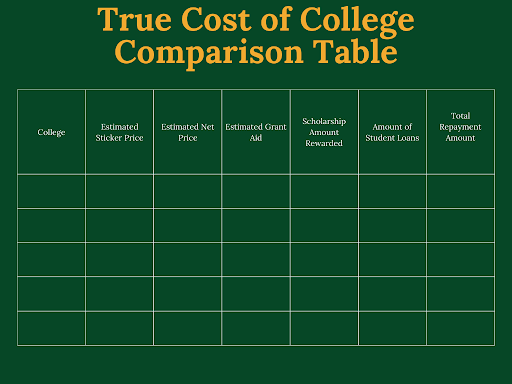One of the first things to pop up in a conversation about college is the price. Why does college cost so much? Is there any way to graduate without paying an arm and a leg? Or being buried in debt? Let’s break down why the price tag is so expensive, and then consider ways to help save on those college costs.
Sticker Price vs. Net Price
Before we can really dive into how much a college costs, we need to review sticker vs. net price.
The sticker price is the advertised cost of a college. Some parents and students see the sticker price and panic. For example, Stanford University’s 2024-2025 tuition is just over $65,000. That doesn’t include other college expenses, such as books or housing. Even students who have a chance of getting into Stanford may see that number, deem it “too expensive,” and cross it off their list.
However, between grants, scholarships, school endowment programs, and other forms of aid, a student usually pays much less than the sticker price. The total amount the student pays is known as the “net price.”
To continue with Stanford, 55% of students attending this university receive grant aid ($64,164 on average) and 55% receive institutional grant aid ($61,082 on average). In addition, 20% are given federal grants worth around $6,651. Only 7% of students have to take out loans ($14,075 on average).
As a result, a student attending Stanford can actually find the school rather affordable after they receive a financial aid package. In fact, the university is one of the top schools in California for middle class affordability.
So, when reviewing colleges, don’t rule out colleges solely based on sticker price. Colleges and universities must provide Net Price Calculators to help you estimate what you could receive if you’re accepted. You could be pleasantly surprised when you receive your financial aid offer letter and the college is less expensive than you may have thought.
How Much Does College Cost?
Even when taking sticker price vs. net price into account, the cost of college is staggering. Some cost upwards of $60,000 per year in tuition and fees alone. And the expense is only rising – since 1963, after adjusting for currency inflation, tuition has increased over 197%.
Between 2010 and 2023, public 4-year institutions saw a 36.7% in-state tuition increase. However, 2023-2024 data from the Integrated Postsecondary Education Data System (IPEDS) from the National Center for Education Statistics (NCES) show that tuition prices dropped between 2021-2022 and 2023-2024. For example, out-of-state tuition at public colleges dropped 7.8%.
The exact cost of college depends on the school. 2-year colleges will almost always cost less than 4-year colleges and universities. Public schools tend to have lower sticker prices than private schools, but endowment programs can make a private college much less expensive than a state university.
How Much Is Tuition at a 4-Year College?
Taking a look at 2021-2022, 2022-2023, and 2023-2024 data from IPEDS, we can see the average cost of tuition and required fees in an academic year. This table covers the past 3 years for full-time, first-time degree seeking undergraduates attending 4-year colleges and universities in the United States.
| Type of Institution | 2021-2022 | 2022-2023 | 2023-2024 |
| Public (In-State) | $9,667 | $8,855 | $8,961 |
| Public (Out-of-State) | $20,953 | $19,188 | $19,397 |
| Private Nonprofit | $34,379 | $31,326 | $32,575 |
| Private For-Profit | $20,316 | $19,001 | $18,694 |
How Much Is Tuition at a 2-Year College?
Here’s a look at the same years, but at 2-year colleges. No surprise here, tuition for a 2-year college is less expensive than a 4-year, so this could be an option for those wanting to cut costs. We also included in-district tuition numbers as some community colleges offer lower rates to individuals in nearby counties.
| Type of Institution | 2021-2022 | 2022-2023 | 2023-2024 |
| Public (In-District) | $4,400 | $3,980 | $4,072 |
| Public (In-State) | $5,194 | $4,688 | $4,815 |
| Public (Out-of-State) | $9,801 | $8,918 | $8,912 |
| Private Nonprofit | $18,474 | $17,095 | $17,786 |
| Private For-Profit | $17,914 | $16,541 | $16,477 |
What Is the Full Cost of Attending College?
Of course, tuition and required fees don’t tell the whole story when it comes to college expenses. The full cost of attendance (COA) accounts for food, housing, personal expenses, books, supplies, equipment, course materials, and transportation.
Many colleges and universities provide breakdowns of these expenses on their websites or in their Common Data Set documentation, so students can better understand the true cost of attending that particular school.
Why Is College So Expensive?
But why is college so expensive? Why was the average cost of tuition and fees over $32,000 per year at a private nonprofit school? There are some of the reasons why colleges charge substantial tuition fees:
Improving Campus Facilities & Amenities
Keeping things up to date costs money. Colleges are constantly upgrading technology and renovating interiors, walkways, common areas, classrooms, libraries, research facilities, and other spaces on campus.
Since many colleges have been around since the foundation of America, there is plenty to upgrade and modernize. And a lot of the time, it’s worth it. Colleges and universities have to keep up with peers to offer up-to-date education that benefits their students, which means installing new technology and resources as they become available.
Plus, creature comforts and added amenities add on to the expense of running a college. Benefits such as air conditioning and expansive gyms cost money. These upgrades make campus life all the more comfortable for students, faculty, and staff, but they’re not free.
Wages and Salary Increases for Faculty & Staff
Colleges, especially large ones, have a lot of faculty and staff on hand, many working behind the scenes. From professors to administrators, wages need to be paid. As the cost of living increases and inflation rises, salaries have to keep up with the faculty and staff’s needs. Even though part-time employees are often paid less than their full-time counterparts, salaries are higher today than they were several decades ago.
If wages aren’t high enough, quality professors and other employees tend to head for the competition, bringing down the overall quality of the entire school. Hiring the best of the best in every field doesn’t come cheap.
Supply & Demand
The fact that many colleges turn away more students than they accept is proof that the demand is higher than the supply. In such a scenario, it’s easy for colleges to increase their cost of tuition without it impacting their acceptance rate. More and more students are going to college than in decades past—and while that has many benefits, it also means that college is going to become more expensive.
A Bachelor’s Degree Is Practically a Necessity Today
Earning a bachelor’s degree is the minimum qualification necessary to get into many professional fields today. As a result, many students have to attend college to enter their desired career, even if that means they have to borrow tens of thousands of dollars to do so. Colleges are well aware of this and know they will attract applicants even if their tuition is high.
Slashed Budgets
The recession of 2008 changed the education landscape in America. Several states cut back on their funding allocations towards higher education. The lack of state funding put the burden of covering operating expenses and financial aid on individual colleges. This left many higher education institutions with no choice but to increase their cost of tuition.
However, recent years show promise. State higher education funding was increased in both 2022 and 2023, with 2023 seeing 6.7% more funding compared to 2008. But whether this is a trend that will stick around remains to be seen. Some believe that the issues with the new version of the Free Application for Federal Student Aid (FAFSA) in 2023 will have a lasting affect on state’s budgets for colleges in the coming years.
Infrastructure Maintenance
American college campuses are self-contained. Every campus has its own academic buildings, residences, parking structures, and other buildings. With electricity, water, heat, and other utilities, the cost of keeping each of these operational can add up. Older buildings are less efficient, and their operational costs are even higher as a result. Colleges simply add these infrastructure costs to the tuition fees.
11 Ways to Make the Cost Of College Less Expensive
Thankfully, even though college is expensive on paper, there are plenty of steps students and their families can take to lower the cost of earning a degree.
1. File the FAFSA
No matter what, file the FAFSA. It’s free, and with the 2023 changes, it’s easier than ever to complete. Many families make the mistake of not filling it out. They’re led to believe that they won’t qualify for federal aid and they don’t want to take out student loans, so what’s the point?
However, Pell Grant income limits change each year, and it’s required for work-study programs on campus. Plus, it’s not only the government that uses this information. The Department of Education can pass your FAFSA results, known as your Student Aid Index (SAI), to the colleges you’re applying to. These schools then use this information to determine financial aid packages for their students, which can include both merit-based and need-based scholarships.
If you fail to complete the FAFSA, you won’t be in the running for this federal aid, potentially causing you to miss out on thousands of dollars in savings.
Even if you completed the FAFSA last year and didn’t receive anything, don’t skip it in subsequent years. Income limits and other requirements, both at the federal and college level, change every year. Schools are also regularly adding new scholarships that you could now qualify for – but only if you complete the financial aid application.
2. Complete State Financial Aid Applications
Some states have their own financial aid applications. While most accept the FAFSA instead of their forms, others will only accept the state-specific application if you want to compete for state-sponsored grants and scholarships. For example, Florida requires students interested in their programs, such as Bright Futures, to fill out the Florida Financial Aid Application (FFAA). They don’t accept the FAFSA.
3. Apply to Scholarships
Scholarships are free money*. While your college and high school may automatically enter you into the running for some of their awards, there are over 1.7 million scholarships available to students through schools, organizations, businesses, nonprofits, and individuals. Most of these require separate applications.
Students can find scholarships they qualify for through scholarship search databases. Don’t skip those low-amount awards, either – win a few of them and they can save you thousands in college costs.
4. Attend an In-State College
State governments subsidize your tuition fees when you attend an in-state college. This can make the cost of college considerably less expensive while still giving you a high-quality education. Many states are also part of reciprocity programs. For instance, California and Colorado are part of the Western Undergraduate Exchange. If you live in California, but want to attend a school in Colorado, you could qualify for in-state tuition costs at select colleges in Colorado.
5. Go to Community College First
Community college tuition is thousands of dollars cheaper than tuition at any public or private 4-year university. Attending a 2-year school first, and then transferring to a 4-year university to finish out your bachelor’s degree can lower your overall college cost by thousands of dollars. More and more students are taking advantage of these 2+2 Programs.
6. Consider Work-Study Programs
Work-study programs are an excellent way to earn while you learn. You’ll get valuable job experience, resume points, all while earning a paycheck. Putting your income towards your college expenses will help bring down your total cost of attendance. However, you’ll have to complete the FAFSA to be considered for these programs.
7. Graduate on Time
The longer you take to graduate, the more you pay towards college expenses. It’s not just the additional tuition fees that you have to bear. There are also the costs associated with housing, food, transportation, and other school supplies.
One of the best ways of graduating on time is by sticking with your major. Take time to explore different areas of study before declaring a major to avoid this issue.
8. Buy Used Textbooks
Buying new textbooks can be a huge expense. Why pay that much when buying used textbooks can cost less than half as much? Every little bit counts when you are looking for ways to reduce the cost of college.
9. Attend Online College or Classes
Online colleges tend to be less expensive than on-campus schools, as they cut down many of the expenses required for on-campus classes. Students won’t have to pay room and board, transportation, or parking, and fewer course materials may be required. In addition, since the college doesn’t have to pay for upkeep for enough campus buildings to house their entire student body, they can pass the cost savings onto their students.
If you’d like to attend an in-person school, you can always opt for occasional online classes, too. Some colleges charge less for online courses, but keep in mind, these classes may be worth fewer credits.
10. Live at Home
If possible, living at home and going to a nearby college can save you thousands of dollars in food, rent or room and board, and other expenses. You can even opt to get a job while you’re in school, and if your parents aren’t charging you rent, you can save that money to put towards other college costs or for use after graduation.
11. Compare Financial Aid Offer Letters
College financial aid offer letters often come with acceptance letters. It’s important to read these over carefully as schools don’t follow the same format and different COAs at different colleges can make it difficult to compare the numbers. An offer that looks great on paper may not be the best deal you received. Use a Financial Aid Offer Letter Comparison Tool to clearly see how much it will cost you to attend each college.
College can cost a pretty penny, but often the true cost of attending a school and earning a degree is much less than the student originally thought. Completing the FAFSA, applying for scholarships, and comparing the net prices of various colleges and universities can help you determine the best school for your educational goals and your wallet’s needs.
Did you know that College Raptor provides estimated net prices for colleges and universities in the United States? Sign up for College Match to learn more.
* While a scholarship does not have to be repaid, there may be other obligations associated with the scholarship.







